Somewhere along the path to becoming one of the dirtiest words in local politics, a funny thing happened to bicycling in Portland in 2014.
If Portland can again build its political momentum toward improving biking, it’ll be more able to take advantage of that momentum than any city in the country.
It started to make an impact where it matters most: Not in photo ops or political promises; but in solidifying key pieces of the foundation required to build lasting change.
If this was the year Portland came to terms with the fact that it’s no longer leading the country in improving biking, it was also the year that gave the city its clearest signs ever of the cultural changes that bike-friendliness can make possible.
The catch is that cultural changes can take 10 years or more to show up. The ship may have stopped moving a few years ago, but the waves from its wake are still hitting the shoreline.
It all adds up to this: if Portland can again build its political momentum toward improving biking, it’ll be more able to take advantage of that momentum than any city in the country.
How does this all work? The answer is written between the lines of the stories we covered this year.
Our retailers are building business models around biking
Green Zebra Grocery is just the beginning of this story. But what a beginning.
Lisa Sedlar’s healthy-convenience-store startup, which said in October that it’s preparing to open its second location and laying the groundwork for its third, is the business Portland planners have dreamed about for decades. Designed to be the anchor of a “20-minute neighborhood” by selling quality fresh food in areas that can’t support full-size supermarkets, it’s also put bikes at the center of its strategy, sparing no expense to construct the city’s best retail bike parking and supporting bike lanes and crossing improvements on Lombard Street.
That’s not all. Love them or hate them, the cookie-cutter retail strips of Portland’s development boom — Salt & Straw, Pine State Biscuits, Little Big Burger — seem to be here to stay. And there’s a reason these thriving local chains always jump into sidewalk-facing storefronts where car parking is scarce rather than strip malls with dedicated parking: the rent is cheaper and the parking lots are redundant because plenty of customers arrive without cars. Out-of-town chains like Baskin-Robbins or Five Guys burgers either haven’t figured this out yet or aren’t taking advantage of it; in the meantime, it’s hard to blame local entrepreneurs for expanding as fast as they can across Portland’s low-car eastside grid.
Our real estate developers have entered an ever-escalating battle for bike-friendliness
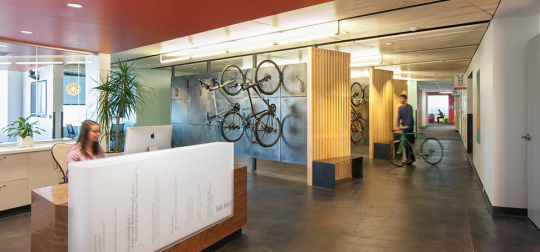
In other cities, bike users are thrilled to have a nice indoor bike parking room in their apartment building. Here in Portland, it looks like we’re about to get a building (419 E. Burnside) with an entire “bicycle lounge” that also features free coffee and Xbox.
I learned this fall how hot the race is to be the city’s bike-friendliest apartment building when I was talking to Wade Lange, the local manager of the huge Hassalo on Eighth development in the Lloyd District. Not only had he read the article we’d posted three weeks before about a local family’s struggles to find cargo bike parking space — his team had already made plans to avoid the problem by setting aside dedicated space in their buildings for cargo, recumbent and electric bikes.
Last year, on-site bike repair stands became standard at new apartment buildings that wanted bike-friendly branding; this year, bike-maintenance vending machines joined the list. Hassalo on Eighth will include a free 12-hour-a-day bike valet and on-site bike shop. New Relic, a fast-growing software company, negotiated a luxurious and beautiful bike parking area into its office lease and dedicates 10 percent of its precious downtown office space to the purpose.
Our activists are back, and they’re badass
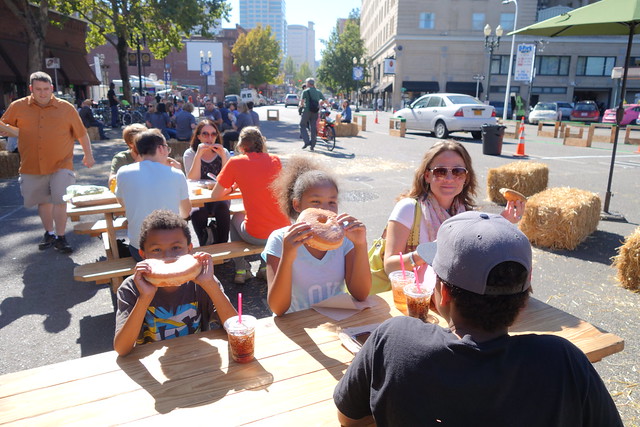
(Photo: Greg Raisman)
In the last few years, the Bicycle Transportation Alliance has made a strategic and perfectly reasonable decision to focus more of its work on Portland’s suburbs. As the advocacy group’s leader Rob Sadowsky told us in May, succeeding in the suburbs sometimes requires softening its radicalism in Portland.
But no sooner did the BTA zig than Portland’s grassroots activists began to zag. This summer and fall, two new volunteer groups, Better Block PDX and BikeLoudPDX, sprung to the front of the city’s consciousness with the sort of direct actions the BTA has decided to avoid.
Better Block, founded two years ago, built an audacious three-day demo of a radically redesigned NW/SW 3rd Avenue with a protected bike lane, pedestrian plazas and a single lane for cars to use. It was a smashing success and seems to have completely changed the neighborhood vision of how to improve Old Town.
BikeLoud, which started after BikePortland reader Alex Reed, reading a comment thread about Portland’s need for a more assertive advocacy group, impulsively typed “I’ll help start one!” and hit “post.” That was the start of a combination of guerrilla actions and traditional advocacy that have already prompted a major review of the city’s neighborhood greenway policy and a proposed new traffic diverter on Southeast Ankeny.
BikeLoud’s message has been so popular that its brand has even been co-opted — this month some people anonymously installed a set of beautiful handmade guerrilla traffic diverters on Clinton, describing themselves as “BikeLoud members” even though the organization hadn’t officially signed off on the plan.
One of the most encouraging signs of all: BTA staffers, who of course share BikeLoud’s goals, have been keeping in touch with the new group behind the scenes. That’s a sign of a truly healthy advocacy ecosystem: The BTA can play one role, BikeLoud can play another, and the whole city will win. It’s a level of sophistication that activists in other cities can only dream of.
Advertisement
Our bureaucracy is an all-star team of bike believers
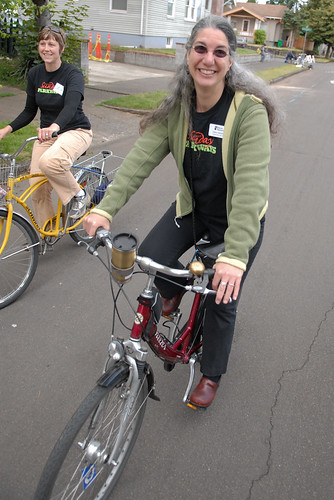
Ginenthal during the Sunday Parkways event that she has
helped shepherd into a revered Portland tradition.
(Photo by J. Maus/BikePortland)
You’ve got to feel sorry for anti-biking skeptics who cheered when former Transportation Director Tom Miller was hounded out of office early last year. Some of them presumably thought they had just cut the head off the beast.
Oops. The beast turned out to be a hydra.
Four months after Miller got sacked, the city’s new mayor and transportation commissioner hired Leah Treat, one of the two closest deputies of one of the country’s most prominent pro-bike bureaucrats, Gabe Klein. (Klein’s other sidekick, Scott Kubly, is now Treat’s counterpart in Seattle.) Treat showed her colors almost immediately, at one point brushing off her own spokesman’s advice and proudly posing for a photo with a bicycle. In February, she went off-script in a podcast interview to say that Vision Zero would be part of Portland’s transportation agenda. She’s also reorganized her department to prioritize long-term plans and thrown herself headfirst, nights and weekends, into the city’s fight for street-improvement funding.
Needless to say, the team Treat leads remains the most bike-oriented transportation department in the United States. From road diet pioneer Rob Burchfield to outreach innovator and Sunday Parkways superstar Linda Ginenthal, there’s only one way to assemble this much talent and knowledge about how to build a great biking city: spend 20 years as the most pro-bike large city in the country.
Portland built. The nation’s bike-friendliest bureaucrats came. If our city has stopped improving its streets, it’s not because they’ve forgotten how. It’s because we’ve forgotten why.
We killed the Columbia River Crossing
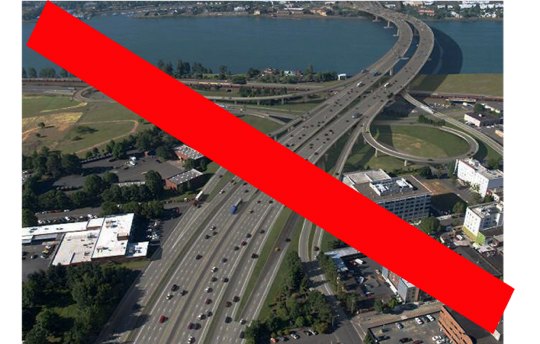
(Image: CRC project rendering)
The single biggest biking victory of 2014 might be the best illustration of Portland’s strengths, because the way we won shows exactly what we’ve lost.
When Oregon’s legislature finally pulled the plug this year on the Columbia River Crossing freeway-rail expansion of Interstate 5, people with short memories said it had been killed by toll-hating conservatives in Washington, not freeway-hating urbanists in Portland.
Baloney. This was a victory for the left as much as for the right.
Step back to see the full picture, and here’s how the Columbia River Crossing died over the course of several years: Portlanders successfully controlled the terms of the deal, making it too progressive for conservatives to sign.
The people to thank for this are two of the most freeway-skeptical, bike-and-transit-friendly leaders the region has ever seen — former Portland Mayor Sam Adams and former Metro President David Bragdon — and the thousands of Portland activists who convinced Adams and Bragdon to keep their distance from the construction and freight interests who wanted more freeway at any cost. They and other progressive Oregon officials (including, yes, Rex Burkholder) refused to support a project without both light rail and tolls. Meanwhile, they wrestled the freeway crossing from 12 lanes down to 10.
That combination was too much for Washington conservatives to swallow. The state’s Republican senate walked away from the deal in 2013, leaving Oregon’s legislature to turn out the lights in March 2014.
In most of this country, $800 million in federal grants could bulldoze through this sort of regional dispute. But Portland stopped the bulldozers with a story — a story it’s since misplaced.
The missing piece of Portland’s puzzle
Here’s the story we’ve forgotten how to tell: Portland can and must become a city where it’s easy and comfortable to get around without a car.
It’s not a story about cars being bad. It’s a story about life being good.
Those 18 words aren’t the whole story, of course, just the heart of it. Different cities embrace biking and low-car life for different reasons. In Austin this year, bike believers have told a story about making room for economic growth without freeway congestion. In Pittsburgh and Calgary, they’ve talked about building cities that young people want to move to rather than flee from. In Portland back in 2007, the leading story was probably that biking is necessary for avoiding catastrophic climate change.
Whatever a city’s reason is for wanting to make bike transportation mainstream, it can’t succeed without making hard choices: choices that create winners and losers. And a city can’t make choices like that without a story that explains why they’re necessary, and how we’ll all become winners in the long run.
Even our biggest triumph in years, the improbable death of the Columbia River Crossing, will only deliver on its promise if we can keep the story going. Like the Mount Hood Freeway before it, a highway that became a light-rail line, the Columbia River Crossing needs to be remembered as the project we rejected in order to build something else.
Portland’s last decade proved that investments in great biking can transform a city’s culture. Its next decade will prove that a pro-bike culture can transform a city’s politics.
In other words, we are the change that Earl Blumenauer and Mia Birk and Elsa Coleman and Jay Graves and Lenny Anderson and thousands of others were waiting for.
Happy new year, Portland. Let’s do this.


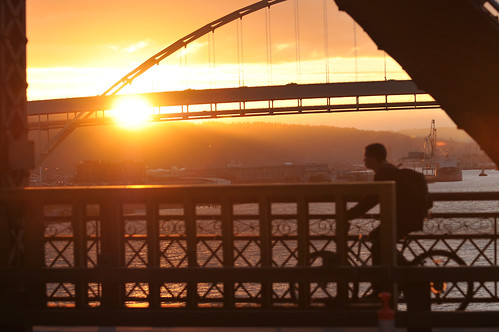
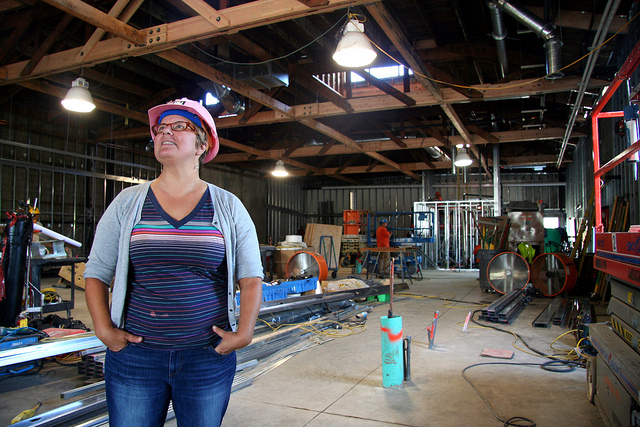

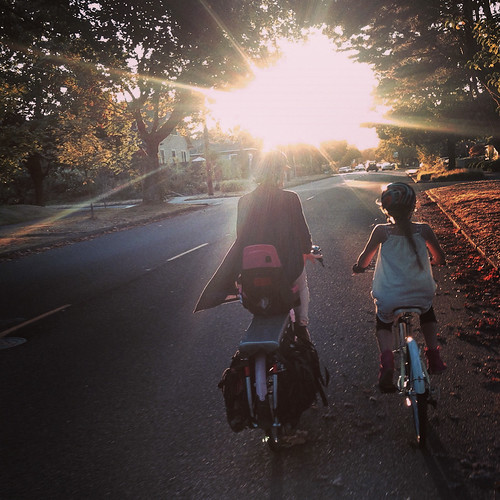
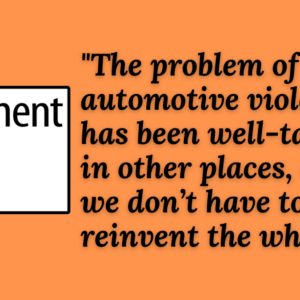

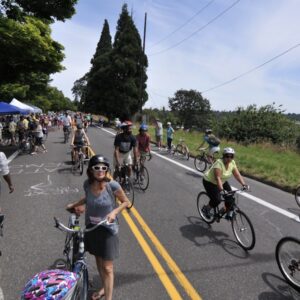
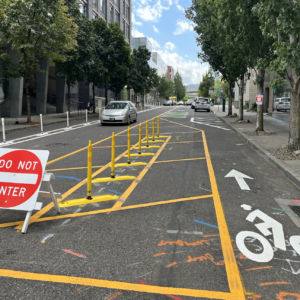
Thanks for reading.
BikePortland has served this community with independent community journalism since 2005. We rely on subscriptions from readers like you to survive. Your financial support is vital in keeping this valuable resource alive and well.
Please subscribe today to strengthen and expand our work.
Beautiful!
Indeed. It is important to remember and be reminded of all the inspiring things going on all the time. Thanks, bikeportland.
Not to be a scrooge, but none of this addresses the real problem which is ever-growing auto congestion on the streets. But I agree with what you say here:
“Here’s our missing story in a nutshell: Portland can and must become a city where it’s easy and comfortable to get around without a car.
It’s not a story about cars being bad. It’s a story about life being good.”
This is correct. In the late 90s/early 00s inner SE/NW was bliss for my commute. Sadly I’ve become far happier driving to places (yes, even short distances) than biking. My bikes were my sole mode of transportation for nearly 20 years but the joy diminished as the streets became more and more threatening with the sheer overload of cars. And yes, I realize the irony in that I’ve now added myself and my car as yet another, but my safety/comfort/happiness is what I’m focused on and riding my bike became far too stressful. I admire those who still do it, but I can’t help but observe nearly every cyclist I see on my commute home looks miserable, scowl on their face, often barking at cars. It really looks unpleasant.
It’s true, I look pretty scowly myself – when I’m riding on car-commute routes (“Sandy!”)
Good on you for not driving on the Neighborhood Greenways – that’s where it’s easier to see smiles.
It seems like you can’t wait to beat your chest in every positive-seeming thread about how much bicycling is awful now compared to your halcyon days and how you used to bike but now love driving your car. Being stuck in the soul-sucking congestion that you’re complaining about (and freely admit contributing to) isn’t much of a factor in your decision, and that’s great, more power to you. But what is the point? What are you trying to achieve here?
Somehow, someway, people still find a reason to bicycle in Portland to get where they need to go because it’s cheap, efficient, healthy, and relatively safe. And I’m not just talking about 20-30 y.o. men, I’m talking about middle-age women, elderly, and families with children. Just because it doesn’t work for you personally, may say more about you than it does about Portland.
Don’t get it twisted, warts and all Portland is still by far the most bicycle-friendly big city in the US. We have it so good here and most of us don’t even realize it.
Beat my chest? I’ve been reading this site since its inception and am very interested in bicycle related progress regardless of me not riding anymore. Your tone and suggestion that somehow I should leave this site (and this state) because I have differing opinions is a bit dramatic, of which you’ll certainly be rewarded with lots of thumbs up from others who wish to drown out any opinion that doesn’t align with their own.
The very title of this post even refers to Portland as a slumping cycling city, so if you want to point to me and blame me for it then knock yourself out but even the editors here admit Portland’s bikeability isn’t what it used to be.
This post ends saying we should get those who don’t feel uncomfortable on bikes to feel comfortable, while you’re basically saying if you don’t feel comfortable you should move to LA. Great job.
“Sadly I’ve become far happier driving to places (yes, even short distances) than biking.”
Perhaps you’d be happier in LA, then?
I agree, it is so much easier driving places. When I lock my bike up outside of a store I never know what parts of my bike I will find missing or sawed off when I come out. At least my car has some element of security from theft and vandalism.
No, because LA is moving in the same direction that we are, namely more density, mixed-use and bicycle infrastructure.
“…My bikes were my sole mode of transportation for nearly 20 years but the joy diminished as the streets became more and more threatening with the sheer overload of cars. …” pixelgate
As a mode of mass transportation in the city, for biking to be successful, in addition to it being a responsible choice, biking also really needs to somehow be a pleasant, enjoyable mode of transportation. Things the city can do to help the enjoyability of biking to not be diminished by excessive motor vehicle use, probably will keep more people interested in biking, as well as drawing the interest of people thinking about biking.
When the weather is nasty, this can be a tough bill to fill, especially where important routes for biking put people riding in intense conditions with motor vehicle congestion. If some city in this metro area ever summons the determination to actually plan and build a full fledged basic cycle track system, I’ll be very interested to see whether this infrastructure, here, can effectively address some of the adversity posed to biking, by excessive motor vehicle use.
I have the same experience as Pixelgate in regards to the motor traffic increasing and changing in temper over the past 5 to 10 years. Scarier still are some of the new motor vehicles. They’re huge powerful machines now that can easily accelerate very fast and much quieter now too. It’s hard to judge their speed anymore. The call by people to not have these too close to our bodies will continue to be here.
” but I can’t help but observe nearly every cyclist I see on my commute home looks miserable, scowl on their face, often barking at cars. It really looks unpleasant.”
Next time you are commuting home at rush hour, take a look at the drivers in the cars around you. They look and behave the same!
If you sit on the side of the road, and see the misery of the motorists, who are the cause of their own problems, their own pains, their own traffic delays, and the cause of many MAX disruptions, killings, and pain in pedestrians and cyclists daily lives – then you might realize that scowl is just a moment, among many of happiness that’ll always exceed being in the cage you’ve put yourself in, and condemned others to face you in.
It is sad you’ve chosen to give up one thing you’ve known, for something you’ve convinced yourself is better even though you admit that you’re contributing to the problems. That’s pretty shameful to admit, with the knowledge you seem to have. Either way, you’re always welcome on any ride I’m taking, if you want to step out of that cage. I won’t hold it against you.
Cheers!
Doesn’t make much sense to me. I usually only have to go five blocks before I run into car-based congestion, which I can circumvent on a bike but wouldn’t be able to in a car.
Great story!
Jonthan thanks for bringing up the point of “What’s Next Post CRC?” in terms of remembering that the value of the whole Mt Hood legacy was what was established after the project was stopped and not just the defense.
Beautiful, uplifting, and proud article, Michael. Thank you.
If all those thousands of people are waiting why don’t they come out and do it as well! The more the merrier!
Great overview and a hopeful viewpoint. Thank you for writing this!
Can we agree that while the city is possibly stagnating for bikes, it’s not slumping?
We’re not seeing a decrease of riders and bike infrastructure.
Portland population outpaces new riders. Numbers are stagnant but percentage is on the decline. Why pretend its not happening when we can acknowledge it and aim to remedy?
because as pointed about above (while the city can certainly strive for better) this is still by far the best big city for cycling in the country.
Michael, you forgot perhaps the biggest news for 2015 – a new car-free bridge will be open for people to bike across. What other American cities can say they built a bridge over a major river that bans cars?
Additionally, I think BikePortland will be posting articles in a year or two highlighting the explosive growth a development that will spring from the new bridge. I wouldn’t be surprised if the daily bicycle counts on the Tillicum Crossing rival the Hawthorne bridge in a couple of years.
The sky’s always falling if you’re Chicken Little.
Great writing and call to action. Thanks.
“It’s not a story about cars being bad. It’s a story about life being good.”
I think that pretty much sums up the approach that we need to take. Not about “us vs them”, but about getting “them” to understand and become part of “us”. Communication.
Excellent, positive, hopeful article!
It may take ten years or even longer, but I predict we’ll look back on 2014 as the year in which the best real chance for a true multi-modal replacement for the Interstate Bridge was lost.
Yes, the CRC could have been made better, but when the time comes for the replacement of the Interstate Bridge after some significant structural issue occurs, the replacement will be much like the I-205 Bridge. It will be 10 or 12 lanes and be ugly as sin and will have only good auto connections. It will not include MAX and will have a bare-bones shared bike-ped facility much like that on I-205. The replacement will be an auto-bridge that doesn’t do anything to promote the use of alternative modes of travel.
As Todd B points out above, the success in not what was stopped, but what was done as a replacement. I fear the replacement in ten or more years will be much worse than what we would have had if the CRC hadn’t been stopped.
I think the future iteration of the CRC will still REQUIRE transit/ped/bike access. The defeat of the CRC was about NOT RAMMING more asphalt down Portland’s throat. There was so much pork and back room lining of pockets in that project it was sickening. I’m proud that our city saw through the smokescreen and called BS on the common automobile industry blind allegiance and promotion that occurs. We denied the construction industries oft repeated “jobs” blackmail scheme. I’m all for supporting our economy and allowing free commerce IF we force those who use cars/roads/bridges etc to pay the REAL cost of driving, not our grossly minimized petro-corpritocracy subsidized costs.
Hear, hear.
Yes. The minimum requirements for bike/ped access and transit will be met with the replacement bridge. The bike/ped access will consist of a single 10-foot shared MUP and circuitous connections. The transit requirement will be met by allowing buses to run in the general purpose lanes across the bridge. I still predict the future river crossing will be much less attractive for bicyclists, pedestrians and transit users than the CRC would have been.
“I fear the replacement in ten or more years will be much worse than what we would have had if the CRC hadn’t been stopped.”
I predict that the current I-5 bridge will never be replaced. And that the share of it devoted to non-motorized transport will increase gradually but steadily. We can shift things around on the bridge(s) we have for a vanishingly small fraction of the cost of replacing them, which in any case was money we never had to begin with.
I’ll bet against the existing bridge lasting forever and being converted to non-auto modes. The need to keep the bridge staffed to raise and lower it for river traffic will cost so much that the fiscal conservatives won’t stand for it. Maintenance costs would be the same whether the bridge is used for autos or bikes.
We’ll just have to wait and see. I used to commute by bike across the existing bridge several times per week for several years. I had been looking forward to cycling across the proposed bridge with separation from autos and trucks, a less circuitous route, and no signalized intersections where I had to wait to get to the bridge.
Unlike you, I’m not assuming that we will still be in a position to just replace this bridge or any bridge some years hence. Right now we take out a big loan, and buy asphalt, steel, and concrete, and a whole lot of engineering with that borrowed money. But one of these days we’ll have trouble buying the asphalt and the concrete and the machinery to assemble all of this. It will either be prohibitively expensive or proscribed for reasons of climate stability, or both.
It looks to me like things are going fairly well there. It’s definitely time to move to the next level though.
I like your idea of there being a story. If we don’t have a story to tell about what we want the future to be, people will make up their own and opponents will write a scary story. Recently I was talking with someone from the suburbs who believed that the goal was to make the entire city be car-free. I don’t know how she got that idea but absent any other view of the future, she was told this.
The new Fanno Creek bridge on SW Oleson Road will also have a removal of all parking along SW Oleson Road for late March, 2015. The new bike lanes will take over those parking spots.
I posted this in the previous article on cyclings stagnation.
I think the average commute, (because of housing cost) it too far for a bicycle commute. It’s time for the state & city governments to promote the E-bike. ODOT put charging stations in across the state for electric cars. Adding infrastructure (charging stations) should be installed at various high bike parking locations (OHSU, City Hall Powells Books, etc.). My ebike extended my 5-10 mile riding range to 10-25 miles. I still pedaled, but arrived not sweaty and tired and could carry more than 20 lbs of cargo. You can poo poo the e-bike all you want, but I would rather have 100 e bikes riding in to town than a 100 cars, anyday.
You may have reached your Maximum bike commuters just due to the amount of people who can afford to live a “bike” commute distance to work. The e bike will increase the possibility of more bike commuters, which will benefit everyone. Including spending more money on bike infrastructure because there are more users.
Time to think outside the bike box
i agree, as i looked for work a few years back, an e bike was in the works if i was going to commute > 10 miles. our city is not YET dense enough to support the #’s of bikers that we all wish to see. e bikes allow 25 mile bike commutes for the non roadies.
Bravo! I think one of the relevant points in this article is that the government picks winners and losers. Every single government action has that effect, and it’s silly to try to design a system that doesn’t feature implicit or explicit biases, often called “nudges” or incentives. One might say, “the government should just leave things like it is,” which would miss the point that there’s a current system of incentives in place that is just not working out, much less sustainable for a future community of many hundreds of thousands of new residents. We just need to incentivize activities that are good for the community.
–
It’s nice to hear someone say this out loud!
I’m a sidewalk superintendent for the New Seasons construction on Woodstock. The foundations are nearly built, in a huge excavation that will be car parking.
The cost of that element of the construction will add to prices in the store, as will the property taxes to be paid in perpetuity.
There is no free parking anywhere.
thats the “true” cost of housing peoples’ cars. its not any of my responsibility to pay for storing someones’ private property. my lettuce shouldn’t have to pay for parking anyone’s car. there is NO SUCH THING as FREE PARKING
“… The foundations are nearly built, in a huge excavation that will be car parking.
The cost of that element of the construction will add to prices in the store, …” Jim Lee
Most likely, the store providing car parking, allows the business to be viable, and merchandise pricing to be accordingly lower. If sufficient numbers of people can’t get to the store to allow it to buy products in great enough numbers to get a break in wholesale price, retail price likely would have to go up.
“the store providing car parking, allows the business to be viable, and merchandise pricing to be accordingly lower.”
That makes no sense, wsbob.
Lisa Sedlar (see above) seems to be demonstrating just how obsolete this kind of thinking is.
Like it or not the vast majority of people still drive to the grocery store (esp. true around Woodstock). Thus providing no parking for these customers would possibly deter them from shopping at the store. Without customers the store would either close or have to raise prices.
I don’t think his reasoning as actually that unsound.
“Thus providing no parking for these customers would possibly deter them from shopping at the store. Without customers the store would either close or have to raise prices.”
Thanks for the opportunity to clarify my reasoning, davemess. First off, spencer started this conversation by acknowledging that the prices—in existing stores with offstreet or underground car parking—are going to reflect these enormous extra costs, so in principle the ‘would have to raise prices’ comment you made would be relative to a lower baseline that did not include the costs of providing this crazy expensive car parking benefit to driving customers.
But before we go that far, I’d like to note that this whole idea that ‘because people now drive to the store that provides car parking’ doesn’t really tell us as much as you’re suggesting it does about how many of those customers would shun the store in the absence of underground or offstreet car parking.
For the Hawthorne New Seasons, where I was vocally opposed to the offstreet/rooftop car parking they claimed at the time the bank made them put in, I still maintain that the store would have done just fine with a majority of customers arriving by means other than a car. It really seems ridiculous and unimaginative to me that New Seasons, of all companies, couldn’t have tested this theory in that location. I don’t know the Woodstock location and demographic enough to speak to that situation, but I also know that one of these days we’re all going to be shopping without such an automatic and heavy reliance on the automobile, and for a grocery store chain to pretend that this future will never arrive is myopic, and as was noted earlier, unfair to those who do arrive by means other than a car, since they too are paying the costs of that underground or rooftop or off street parking with every purchase they make.
As I suggested at the time the Hawthorne New Seasons was being built, there are many creative and inspiring ways New Seasons could have rewarded their existing nonmotorized customers (and encourage those who still get there by car to switch, had they gone the other route.
some of my argument back in 2010:
It is (for the foreseeable future) possible and perhaps even likely that folks will ‘drive anyway’–unless someone takes leadership and actively encourages some and discourages other travel behaviors. But I would think that New Seasons could be a leader on this and put out a press release and a banner over their front door saying something along the lines of the following:
“We built this store here to attract neighbors within a 1 mile radius. We welcome those who walk and bike and take the bus. In fact, since we saved $750,000 (# made up by me) by not building elevated parking at this site we’ll give everyone who arrives here by a means other than a car a 10% discount for the first year–and perhaps even beyond. Thanks for shopping at New Seasons!”
“but I also know that one of these days we’re all going to be shopping without such an automatic and heavy reliance on the automobile, and for a grocery store chain to pretend that this future will never arrive is myopic,”
yes, you do consistently bring this point up. Problem is that most companies (and governments) are not in a position to risk their businesses on a possible (read: not assured) scenario in the future.
I’m confused as to why a business building parking on their own land (not increasing their building footprint) is that controversial? This theoretically allows for more density and less on street “free” store parking, which is space many on here would like to see used for more actual traffic movement (pedestrian, bikes, etc.)
I get your reasoning, but is it a practical way for a corporation to run their business in 2015? Apparently New Seasons thinks not.
I hear you, and your reasoning is, no doubt, very much like the reasoning these corporations and governments are using.
However… you wrote: “most companies (and governments) are not in a position to risk their businesses on a possible (read: not assured) scenario in the future.”
To which I’d respond. Most companies (and governments) are right now risking their businesses and countries on the hunch that a possible (read: not assured) scenario will occur in the future. Not only that, no one really believes anymore that we’re *not* running out of cheap oil (the argument is whether this will occur in 1 year or 5 years or 10; all well within the lifetime of these parking garages we’re talking about).
“I’m confused as to why a business building parking on their own land (not increasing their building footprint) is that controversial? This theoretically allows for more density and less on street “free” store parking, which is space many on here would like to see used for more actual traffic movement (pedestrian, bikes, etc.)”
You are allowing for only two possibilities
(a) people will drive willy nilly and park in the parking garage, or
(b) people will drive willy nilly and park on the street.
But that is needlessly constrained, and a static view, to boot. We know (don’t we?) that if you leave off the offstreet parking, that
(a) plenty of customers already don’t drive,
(b) some who used to drive might discover that they can get there without driving, especially if the parking is no longer so convenient, and
(c) didn’t Lisa Sedlar show us (above) that this very business model is actually viable right here, right now?
“I’m a sidewalk superintendent for the New Seasons construction on Woodstock.”
Can I ask what this job entails? Do you know when the sidewalk will be open again?
Source, Jim? Proof that parking raises food prices? New Seasons knew that if it did not provide parking the neighbors would be furious and not shop there. Where would the parking fairy put the 75% of shoppers who will drive there?
“New Seasons knew that if it did not provide parking the neighbors would be furious and not shop there. ”
Wow, you really do think the world is static – that if everyone drove yesterday then everyone will drive tomorrow. Can you conceive of this as a dynamic problem, one in which said customers might—just might—be capable of learning a new trick one day, of getting to a given store by some other means than their car? You know, we wouldn’t be where we are today if folks hadn’t tried new things, learned new tricks, given up or never acquired a car.
I know you don’t think this is possible but biking can be infectious. Ask anyone who bikes regularly if they would trade their way of getting around for a car. And if you do, please report back.
If biking is contagious, then the infection has certainly been contained.
I understand that things are not static. But that doesn’t mean your predictions are accurate.
Again- I am familiar wit the neighborhood associations. Woodstock residents don’t agree with the anti-car, deliberate congestion approach.
Were any lessons learned from Clinton? People do what they like. You can’t manipulate their behavior. They wanna drive they gonna drive.
“I understand that things are not static”
“They wanna drive they gonna drive.”
I don’t think you’ve really grasped the meaning of the word ‘static.’
One day wanning to drive is not going to be enough. Constraints trump wants any day.
It’s not a story about cars being bad.
I really enjoyed this piece but the above phrasing comes across as overly apologetic to me.
Guns aren’t bad either…
Hear, hear.
cars are bad, and the sooner we swallow that pill the better for everyone. Which isn’t to say that focusing on the positive isn’t useful, but I don’t agree that a positive emphasis requires us to swing the pendulum all the way back. Our dependence on the almighty car has wrecked our neighborhoods, our city, our economies, our political process, and our planet.
Great article. Thanks for writing it. I’d like to add, if I may, that there is a lot to be optimistic about on the “dirt” side of things, as well. The Northwest Trail Alliance is almost 1,000 members strong. There are new trails being constructed in somewhat nearby places for different skilled riders, like Stub Stewart and Cascade Locks. More kids are getting tires on dirt thanks to the effort put into Take A Kid Mtb’ing Day. Events like Trail Fest (and many others) continue to bring together the off-road community. I am optimistic that this is just the beginning. Hell, I’m even hopeful that we will soon be able to Ride to Where We Ride on decent singletrack with varying degrees of difficulty.
Cheers!
Thanks for that note, Brian. I had been planning to explicitly mention NWTA’s great work in the activism section but it was getting longish so I stuck to the “streets” stuff. Anyway, totally agreed that this too is part of the 2014 resurgence in activism and part of what has me feeling good about 2015.
It’s great news that there is so much to write about! Happy New Year Michael and everyone else. See you all out on two wheels of one form or another.
And Brian,
You might recall that I wrote an entire article about mountain biking optimism back in November:
After years of disappointment, single track lovers have reasons for optimism
2015 is the year that portland will catch up in the Mountain Bike world. You can’t be a “bike friendly” city without mountain biking.
Not in *my* Forest Park you don’t!
As I see it, the CRC is dead for a long time for several reasons:
1. Washington State has no money for it. The Alaska Way Viaduct tunnel (or whatever they’re calling it) is turning into a cluster of problems and is going to eat up all of that state’s transportation dollars for some time.
http://grist.org/cities/seattles-unbelievable-transportation-megaproject-fustercluck/
2. Vancouver seems to be easy for the rest of the state to ignore.
3. Federal transportation dollars are drying up as the highway trust funs runs out of money.
Put those factors together, and nothing will happen with the bridge until the old one either falls into the river or develops such safety problems that it appears that it is truly about to fall. Because of the money problems, any CRC project will have to be minimalistic, with no interchange work, no rail, no bike/ped component. If we get lucky, we might end up with one of the old spans saved for bike/ped and *maybe* light rail, if the bridge is easily adapted for that, but don’t count on it.
ride a bike and smile more.
Thanks for the great article. A nice summary of the year. We’ve got work to do but I appreciate Portland every day on my commute. Definitely less scowls on bike than in my car. And thanks to bikeportland for your coverage of the city and beyond. Was inspired this year by ongoing conversation about increasing the bike mode share, stories about Slow Roll in Detroit, and bike infrastructure improvements in places like DC and NYC, which benefit all of us who want more livable spaces.
Vision trumps realty. What might be trumps what is. Examples trump plans. A wonderful demonstration of the power of demonstration. Straw bales and empty drums can do more than years of meetings. Both matter, but without vision, the city doth perish. Thanks to all who make things happen.
Thanks Michael for your fine thoughts on where Portland is and where its heading…if we keep our eye on the prize! Together you and Jonathan have been a big part of the last decade’s progress.
As the lone NO vote on the CRC at the conclusion of the Governors’ I-5 Task Force in 2002, I appreciate the turn around that the last decade has brought on that project. I recall how about a year into that multi-year process as the consultants reported their data, it occurred to me ( a recently laid off “imaging technologist” for Boise Cascade Paper R&D) that what that data called for was a local bridge, a “Broadway Bridge,” with good transportation options. Simply put “more choices and correct pricing.” The TF split down the middle on that option, the DOTs ignored our advice, and they paid the price, an unfunded project…thank heavens!
At this point we should focus on getting the pricing right for the bridges we have, creating an income stream for seismic upgrades, for fixing the RR bridge to reduce lifts, for extending light rail to Hayden Island and so on.
I am a “sidewalk superintendent” in the same way Thoreau was an “inspector of snowstorms.” Do not know when they will reopen.
Almost all my shopping is at Trader Joe’s and Winco. I use New Seasons rarely, and only for its excellent meats and veggies, the best around, with prices to match. NS knows its customers well. Selection of ordinary groceries is sparse; I see interminable numbers of cake and pancake mixes, but no corn meal and no baking powder; same for TJ’s; must head to Winco when I need to bake. A potato at Winco costs half of a potato at NS. Both NS and TJ’s stock the brand of Irish butter I like, but NS charges about $1 more.
All three stores have “ample” parking; if they did not they would not draw customers from Safeway and Freddie’s. I ride the 71 bus to Winco; NS & TJ’s I access via fixie & backpack. Hint: parking lots are a boon to fixers! Handling skills are paramount! One must ride AGAINST car traffic, dodging everything in sight: parents, kids, carts, Subarus!
TJ’s is the most interesting store around; its dollar volume per square foot is nearly twice Safeway’s or Freddie’s. TJ’s carries about one-tenth the products of a traditional supermarket, and customers move through quickly, which in turn reduces the need for car parking. But it rarely has adequate bike parking.
At Winco multiple shoppers tend to arrive in large vehicles, filling huge carts with lots of stuff, which then discharge into said vehicles. Still, a pretty good sized parking lot.
Thanks for the comments, people!
Blush. Thanks Jonathan. More to come in 2015! Stay tuned.
Great article, Michael! I hope that these really are all reasons for optimism in 2015; we need it, for sure! And great inclusions from folks about the optimism regarding desperately needed (and decades-overdue) urban mountain biking options.
We also need to keep learning from the great things being done in other cities around the world–places where car-free infrastructure has been implemented and rigorously tested.
For example, I was in Little Rock (I know, Arkansas, of all places!) a few weeks ago, and I was BLOWN AWAY by how bike-friendly their River Market district is. They have a bridge built in 1884 that looks *just* like the Hawthorne bridge, and it’s now 100% car-free! It’s also permanently in the raised position, so the views are really dramatic. Even their “Morrison” bridge (just a short ways upriver, right next to the Clinton Library) is totally car-free now, too! They also have their hideous interstate bridge, just like the Marquam. But they also have a large restored wetlands area and trails with interpretive signs that line the river between River Market and the Clinton Library.
Can you IMAGINE having a CAR-FREE Hawthorne bridge? Or seeing those **awful** freeway-style ramps removed from the Morrison bridge? I never even thought of it until visiting Little Rock, of all places.
It was incredibly eye-opening to see what Little Rock has accomplished. The River Market district is on an 18-mile bike path right along the Arkansas River. And 7 miles from River Market (which has 10 museums, a REAL public market, a 3-story bookstore, a 5-story library, dozens of great sculptures, stunning cafes in 120-year-old buildings, a huge riverfront playground, many educational areas/exhibits, etc…), you arrive at what is by far the longest bike/ped bridge in all of North America!
If a mid-sized city in Arkansas can accomplish all this in less than a decade, I hope we can expect MUCH more progress in the very near future in the Portland area…
This is the sort of article that makes me so glad I became a Bike Portlander! Great work, Michael!
I think the problem that Portland faces in terms of being attractive to new young residents is that it MUST find a way to remain affordable as well as desirable. And there is simply no way to do that without large scale and systematic removal of car dependency! Any other way the city grows without doing that will lead to the destruction of affordability AND desirability.
So, either Portland realizes this and we wind up with the bike infrastructure we deserve, or it doesn’t, in which case nothing matters because we will see all the creative people leave.
I have great hope that we can do this right.
I agree with much of what you say, peejay, except I don’t think I’ll ever understand why we would seek to be attractive to NEW young residents. Why can’t we seek to make this work for the residents who are already here? Focusing on the not-yet-here inevitably causes us to skip over the ones who live here, but can already not afford things. Adding more, welcoming more can’t but increase this pressure. It seems utterly backwards to me.
I’m hoping that increased density just make it more apparent that our city won’t be very functional if everybody drives. We have thousands more residential units in inner Portland currently in comparison this time last year, and there are many more in the pipeline, and I’m hoping that will be enough to drive home this point. It will be easier to get everything done that you want to do without driving, in part due to increased number of mixed-use buildings and in part due to online delivery services. It will probably also become more of a pain in the ass to drive, once parking restrictions are rolled out.